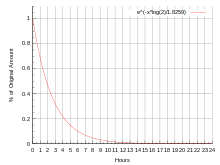Fluorine-18
Fluorine-18 (18F) is a fluorine radioisotope which is an important source of positrons. It has a mass of 18.0009380(6) u and its half-life is 109.771(20) minutes. It decays by positron emission 97% of the time and electron capture 3% of the time. Both modes of decay yield stable oxygen-18.
 Decay over 24 hours | |
| General | |
|---|---|
| Symbol | 18F |
| Names | fluorine-18, F-18, Fluorine-18 |
| Protons | 9 |
| Neutrons | 9 |
| Nuclide data | |
| Natural abundance | Radioisotope |
| Half-life | 109.771(20) min |
| Decay products | 18O |
| Isotope mass | 18.0009380(6) u |
| Spin | 1+ |
| Excess energy | 873.431± 0.593 keV |
| Binding energy | 137369.199± 0.593 keV |
| Decay modes | |
| Decay mode | Decay energy (MeV) |
| Positron emission (97%) | 0.6335 |
| Electron capture (3%) | 1.6555 |
| Isotopes of fluorine Complete table of nuclides | |
Synthesis
In the radiopharmaceutical industry, fluorine-18 is made using either a cyclotron or linear particle accelerator to bombard a target, usually of pure or enriched [18O]water[1] with high energy protons (typically ~18 MeV protons). The fluorine produced is in the form of a water solution of [18F]fluoride, which is then used in a rapid chemical synthesis of the radiopharmaceutical. The organic oxygen-18 pharmaceutical molecule is not made before the production of the radiopharmaceutical, as high energy protons destroy such molecules. Radiopharmaceuticals using fluorine must therefore be synthesized after the fluorine-18 has been produced.
Chemistry
Fluorine-18 is often substituted for a hydroxyl group in a radiotracer parent molecule, due to similar steric and electrostatic properties. This may however be problematic in certain applications due to possible changes in the molecule polarity.
Applications
Fluorine-18 is one of the early tracers used in positron emission tomography (PET), having been in use since the 1960s.[2] Its significance is due to both its short half-life and the emission of positrons when decaying.
Tracers include sodium fluoride which can be useful for skeletal imaging as it displays high and rapid bone uptake accompanied by very rapid blood clearance, which results in a high bone-to-background ratio in a short time[3] and fluorodeoxyglucose (FDG), where the 18F substitutes a hydroxyl. New dioxaborolane chemistry enables radioactive fluoride (18F) labeling of antibodies, which allows for positron emission tomography (PET) imaging of cancer.[4] A Human-Derived, Genetic, Positron-emitting and Fluorescent (HD-GPF) reporter system uses a human protein, PSMA and non-immunogenic, and a small molecule that is positron-emitting (18F) and fluorescent for dual modality PET and fluorescence imaging of genome modified cells, e.g. cancer, CRISPR/Cas9, or CAR T-cells, in an entire mouse.[5]
References
- Fowler J. S. and Wolf A. P. (1982) The synthesis of carbon-11, fluorine-18 and nitrogen-13 labeled radiotracers for biomedical applications. Nucl. Sci. Ser. Natl Acad. Sci. Natl Res. Council Monogr. 1982.
- Blau, Monte; Ganatra, Ramanik; Bender, Merrill A. (January 1972). "18F-fluoride for bone imaging". Seminars in Nuclear Medicine. 2 (1): 31–37. doi:10.1016/S0001-2998(72)80005-9.
- Ordonez, A. A.; DeMarco, V. P.; Klunk, M. H.; Pokkali, S.; Jain, S.K. (October 2015). "Imaging Chronic Tuberculous Lesions Using Sodium [18F]Fluoride Positron Emission Tomography in Mice". Molecular Imaging and Biology. 17 (5): 609–614. doi:10.1007/s11307-015-0836-6. PMC 4561601. PMID 25750032.
- Rodriguez, Erik A.; Wang, Ye; Crisp, Jessica L.; Vera, David R.; Tsien, Roger Y.; Ting, Richard (2016-04-27). "New Dioxaborolane Chemistry Enables [18F]-Positron-Emitting, Fluorescent [18F]-Multimodality Biomolecule Generation from the Solid Phase". Bioconjugate Chemistry. 27 (5): 1390–1399. doi:10.1021/acs.bioconjchem.6b00164. PMC 4916912. PMID 27064381.
- Guo, Hua; Harikrishna, Kommidi; Vedvyas, Yogindra; McCloskey, Jaclyn E; Zhang, Weiqi; Chen, Nandi; Nurili, Fuad; Wu, Amy P; Sayman, Haluk B. (2019-05-23). "A fluorescent, [ 18 F]-positron-emitting agent for imaging PMSA allows genetic reporting in adoptively-transferred, genetically-modified cells". ACS Chemical Biology. 14: 1449–1459. doi:10.1021/acschembio.9b00160. ISSN 1554-8929. PMC 6775626. PMID 31120734.
| Lighter: fluorine-17 |
Fluorine-18 is an isotope of fluorine |
Heavier: fluorine-19 |
| Decay product of: neon-18 |
Decay chain of fluorine-18 |
Decays to: oxygen-18 |